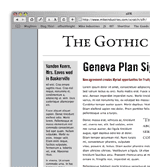sIFR 2.0: Release Candidate
UPDATE: Version 2.0 is now available. See article here.
Alright, we have a solid release candidate! This evening, I present sIFR 2.0 Release Candidate 1, and unless any major problems are found, this will end up being the exact code in the final release. I want to thank everyone who has put sIFR through its paces and helped Mark and me squash bugs and add feature enhancements. It wasn’t until I released sIFR that I fully realized the power of open source. What may have taken months to develop otherwise, instead took only weeks… and only evenings at that. I know I still have to create the official sIFR primer and idiotproof instructions, so I’ll be doing that over the next week or so and monitoring this comment thread for any issues which may arise. The download is here and the updated example is here.
And since David Guillory asked, it is indeed pronounced “siffer”. Spread the word to the homies.
What’s new in this release
Here are some details about sIFR 2.0 RC1:
- This release was mostly for fine-tuning. The concentration was on stability and reliability.
- Proper uppercasing is now supported and it won’t mistakenly uppercase your URLs in the process. Please note that “upper” or “lower” are now passed in as the last parameter of the function to induce uppercasing or lowercasing. This is the only change which may affect existing implementations.
- Various DOM and speed improvements.
- More consistent font sizing.
- Support for common usually-escaped characters like “, ‘, &, and %.
- Automatic whitespace-stripping, following the same conventions as HTML.
- Complete IE 5 Mac compatibility.
Quick Instructions
The usage instructions are identical to the previous betas with the exception of the upper/lowercasing change mentioned above. Here is what to do:
- Download 2.0 Release Candidate. sIFR is licensed free of charge under the standard CC-GNU LGPL.
- Get familiar with index.html. That’s really the only file which contains the things you’ll need to adapt. It contains the replace statements at the bottom and the CSS at the top.
- To make your own .swf files, simply open up the .fla file in Flash, doubleclick the textbox which is on stage (it takes up the whole stage), and choose your own font from the Properties palette. Then, choose File > Export and you’re done!
- The parameters to use in your replacement functions are explained in the html file. Plug in your parameters and you’re good to go!
Additional Notes
You won’t have to replace any of your existing replace statements (from beta 2) unless they are affected by the upper/lowercasing change mentioned above. You need only replace your .js file and your .swf files. You may notice a slight font sizing difference between the last beta and this release. This release’s sizing is more correct and consistent so please roll with the new.
There are only two significant issues I know of which remain unsolved:
- Possible weirdness in certain versions of Opera.
- Certain typefaces, especially script fonts, may contain characters with non-conventional metrics which can cause clipping of letters in some cases. An example is a handwriting font (like Cezanne, for instance) where the crossbar on the “t” extends far beyond the width of the T. Sort of like if you were signing your name and you dragged the tail end of the last letter back over the word. The problem with this sort of font is that Flash is unaware of the stray strokes. The only solution to this, moving forward, is for users to manual adjust the left and right margins in the Formatting palette in Flash if necessary. I don’t consider this necessarily “solving” the issue, but if you find yourself in this predicament with an ornate script font, give it a try.
 The #1 movie site on the internet just got a facelift yesterday. Thanks to the tireless efforts of
The #1 movie site on the internet just got a facelift yesterday. Thanks to the tireless efforts of  Hot on the heels of the
Hot on the heels of the  With our last redesign in 2003, ESPN.com launched a revolutionary video feature called “ESPN Motion”. By downloading high quality video transparently to users’ hard drives, we were able to give our viewers, free of charge, some of the highest quality video on the web, with no waiting, no buffering, and no noticeable encoding artifacts. With a simple installation of the little ESPN ActiveX control, users could watch freshly cut ESPN video right within our front page.
With our last redesign in 2003, ESPN.com launched a revolutionary video feature called “ESPN Motion”. By downloading high quality video transparently to users’ hard drives, we were able to give our viewers, free of charge, some of the highest quality video on the web, with no waiting, no buffering, and no noticeable encoding artifacts. With a simple installation of the little ESPN ActiveX control, users could watch freshly cut ESPN video right within our front page. “Double Accidental Excellence / Awesomeness”
“Double Accidental Excellence / Awesomeness” Without further ado, I present for download
Without further ado, I present for download